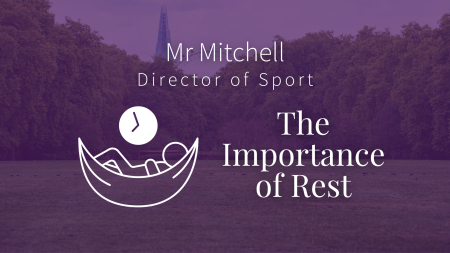Related articles
Our Director of Sport, Mr Mitchell, recently led an assembly with our Year 10s on the Importance of Rest, using findings published by Dr. Dalton-Smith, a leading researcher and physician focused on improving sleep, preventing burnout, and increasing overall health and well-being. He spoke to us on the topic and shared the 7 Types of Rest below.
Mr. Mitchell, Director of Sport:
“Rest is an essential component of overall well-being, and it is crucial for both physical and mental health. Getting enough sleep, taking breaks, and engaging in leisure activities can help one to feel more energised, focused, and productive in their daily life. As adults, we are better equipped to handle stress, manage emotions, and make good decisions when we are well rested. The same is true for young people, especially within Year 10, when it comes time to begin the GCSE programme.
As the head of this year group, I am aware that they are constantly juggling various academic and personal commitments, from additional classes and completing academic work to participating in extracurricular activities and spending time with friends and family. Amidst all of these obligations, it is important that they are reminded to prioritize rest and relaxation (It sounds counter-intuitive, I know!).
While it can be tempting to push yourself to the limit in order to achieve your goals, it is important to remember that your personal life and social relationships also require attention and care. By setting aside time for reflection, relaxation and social activities, you can improve your overall quality of life and reduce the risk of burnout.”
The 7 Types of Rest
- Physical Rest
According to Dr. Dalton-Smith, physical rest can be divided into two categories: passive or active. Passive rest includes activities such as high-quality naps or power naps, while examples of active rest can include stretching or breathing exercises. - Mental Rest
Mental rest occurs by providing the brain with breaks and activities that involve little brain power, allowing the individual time to regain energy after demanding tasks. - Sensory Rest
This type of rest involves breaks from constant stimuli, i.e., phones, and television or computer screens. Implementing a phone-free bedtime routine or silencing distracting notifications throughout the day are two examples that can prove beneficial. - Creative Rest
Participating in creative activities can allow for the mind to reset and to feel one’s sense of mindful awareness restored. - Emotional Rest
Emotional rest occurs whenever the time is taken to express one’s emotions without fear of judgment. Examples include speaking to a trusted family member or friend, or keeping a journal. - Social Rest
Social rest means taking a step back from engaging in too many social interactions, which can feel overwhelming after a while. Examples of this type of rest include spending quality time with a close friend; saying “no” to a demanding social event; or limiting communication for short periods of time to recuperate. - Spiritual Rest
Despite its name, spiritual rest doesn’t mean taking a break from your spiritual life but leaning into it. This will mean something different to every individual but occurs when one is able to forge a deep sense of connection and acknowledgement of one’s feelings and emotions.






